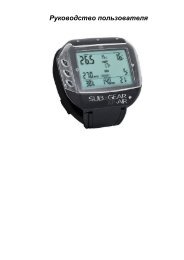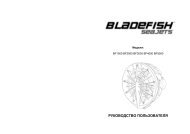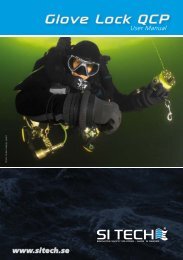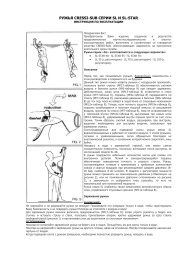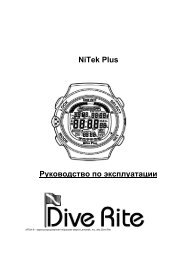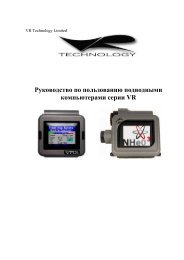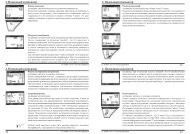Galileo SOL Manual - Scubapro
Galileo SOL Manual - Scubapro
Galileo SOL Manual - Scubapro
You also want an ePaper? Increase the reach of your titles
YUMPU automatically turns print PDFs into web optimized ePapers that Google loves.
3. Diving with <strong>Galileo</strong><br />
- class 1: from approximately<br />
1000m/3300ft to approximately<br />
2000m/6600ft (switch point at<br />
815mbar);<br />
- class 2: from approximately<br />
2000m/6600ft to approximately<br />
3000m/10000ft (switch point at<br />
725mbar);<br />
- class 3: from approximately<br />
3000m/10000ft to approximately<br />
4000m/13300ft (switch point at<br />
610mbar);<br />
- class 4: above approximately<br />
4000m/13300ft. In this altitude class<br />
<strong>Galileo</strong> functions in gauge mode only<br />
(automatic switch from computer mode).<br />
The altitude classes are defi ned in terms of<br />
approximate elevations because the effect<br />
of weather conditions can make the switch<br />
point pressure occur at different levels.<br />
3.6.1 Prohibited altitude<br />
Going to altitude, as much as fl ying after<br />
diving, exposes your body to a reduced<br />
ambient pressure. In a way similar to the<br />
no-fl y time, <strong>Galileo</strong> advises you which<br />
altitude classes are safe to reach after a<br />
dive and which aren’t. If you have to drive<br />
over a mountain pass to return home after<br />
a dive, it can be quite important to have this<br />
information.<br />
No deco data<br />
gauge mode<br />
Switch point at 610 mbar / 8,85 psi<br />
4000 m<br />
13120ft<br />
3000 m<br />
9840ft<br />
2000 m<br />
6560ft<br />
1000 m<br />
3280ft<br />
0 m<br />
The prohibited altitude classes are<br />
displayed by grey segments inside the<br />
stylized mountain. This can be combined<br />
with black segments indicating current<br />
altitude. In the example above, the diver is<br />
presently at altitude class 2 and should not<br />
reach altitudes of class 4.<br />
Switch point at 725 mbar / 10,51 psi<br />
Switch point at 815 mbar / 11,82 psi<br />
Switch point at 905 mbar / 13,82 psi<br />
<strong>Galileo</strong> deals with altitude automatically: it<br />
monitors the atmospheric pressure every<br />
60 seconds, even when it is turned off, and<br />
if it detects a suffi cient drop in pressure, it<br />
does the following:<br />
- it switches on (if it was off);<br />
- it indicates the new altitude range by<br />
means of black segments inside the<br />
stylized mountain and, if applicable, the<br />
prohibited altitude range;<br />
- it indicates the desaturation time, which<br />
in this case is an adaptation time to<br />
the new ambient pressure. If a dive<br />
is started during this adaptation time,<br />
<strong>Galileo</strong> considers it a repetitive dive,<br />
since the body has residual nitrogen.<br />
<strong>Galileo</strong> has an altitude alarm: if you were to<br />
reach an altitude that according to <strong>Galileo</strong><br />
is incompatible with your current residual<br />
nitrogen levels, it will warn you with an<br />
altitude alarm (see section 1.4 for more<br />
information).<br />
3.6.2 Decompression dives<br />
in mountain lakes<br />
In order to assure optimal decompression<br />
even at higher altitudes, the 3m/10ft<br />
decompression stage is divided into a<br />
4m/13ft stage and a 2m/7ft stage in altitude<br />
ranges 1, 2 and 3.<br />
If atmospheric pressure is below 610mbar<br />
(altitude higher than 4000m/13300ft), no<br />
decompression calculation is carried out<br />
by <strong>Galileo</strong> (automatic gauge mode). In<br />
addition, the dive planner is not available in<br />
this altitude class.<br />
60



